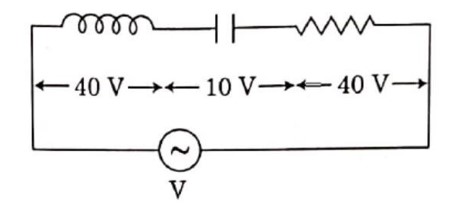Physics Alternating Current
Get insights from 90 questions on Physics Alternating Current, answered by students, alumni, and experts. You may also ask and answer any question you like about Physics Alternating Current
Follow Ask QuestionQuestions
Discussions
Active Users
Followers
New answer posted
2 months agoContributor-Level 10
Diameter = main scale reading + (circular scale reading * least count)
Diameter = 0 + (52 * 0.01 mm) = 0.52 mm = 0.052 cm.
In the RLC circuit:
Given I? = 10√2 A, so I? = I? /√2 = 10 A.
V? = √ [V? ² + (V? - V? )²] = √ [40² + (40 - 10)²] = √ [1600 + 30²] = √ [1600 + 900] = √2500 = 50 V.
Impedance Z = V? / I? = 50 V / 10 A = 5 Ω.
For Hindi: I? = 10√2 A, V? = 50V, Z = V? /I? = 50/ (10√2) = 5/√2 Ω.
New answer posted
2 months agoContributor-Level 10
Capacitive reactance (say) on decreasing the operating frequency reduces
As is inversely proportional to the value of increase
As
increases, therefore displacement current Id decreases.
New answer posted
2 months agoContributor-Level 10
z = √ [R² + (X? - X? )²] = √ [6² + (4-10)²] = 6√2 Ω
Power factor = cosφ = R/z = 6/ (6√2) = 1/√2
New answer posted
2 months agoContributor-Level 9
T = 2π√ (l/g) ⇒ g = 4π²l/T²
Percentage error: Δg/g = Δl/l + 2 (ΔT/T) = (0.1/10.0) + 2 (0.005/0.5) = 0.03
Percentage error = (Δg/g) * 100 = 3%
ω = 2πf = 100π rad/s
i_rms = i? /√2
While current changes from its maximum to its rms value, its phase changes by π/4 rad.
t = (π/4)/ω = π/ (4 * 100π) = 2.5 * 10? ³ s = 2.5ms.
New answer posted
2 months agoContributor-Level 9
Resonance frequency is independent of R.
Quality factor = ωL/R ⇒ Quality factor decreases with increase in R.
Bandwidth of resonance circuit = R/L ⇒ increases with increase in R.
New answer posted
2 months agoContributor-Level 10
I = I? sin (ωt) + I? cos (ωt)
This can be written as I = I? sin (ωt + φ), where I? = √ (I? ² + I? ²)
A hot wire ammeter reads the rms value of the current.
I_rms = I? /√2 = √ (I? ² + I? ²)/√2
Taking an Exam? Selecting a College?
Get authentic answers from experts, students and alumni that you won't find anywhere else
Sign Up on ShikshaOn Shiksha, get access to
- 65k Colleges
- 1.2k Exams
- 679k Reviews
- 1800k Answers

